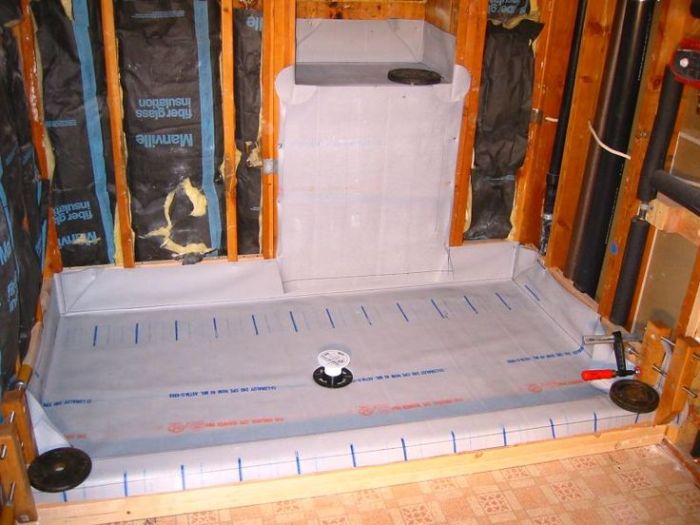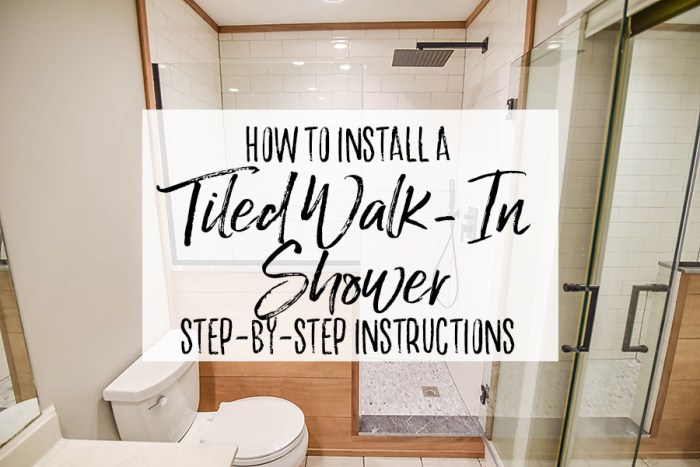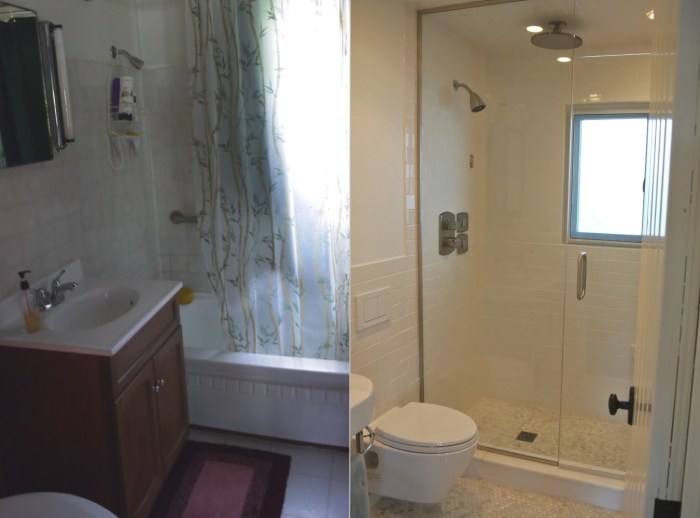Walk-in showers are a popular choice for homeowners looking to create a luxurious and accessible bathroom space. With their curbless design and ease of entry, they offer a safe and convenient showering experience for people of all ages and abilities.
Building a walk-in shower floor requires careful planning and execution. From selecting the right materials to ensuring proper drainage, there are several key considerations to keep in mind. This guide will provide you with all the information you need to build a beautiful and functional walk-in shower floor that will last for years to come.
Materials for Walk-In Shower Floors
Walk-in shower floors require materials that are both durable and aesthetically pleasing. Several options are available, each with unique advantages and drawbacks.
Tiles
Tiles are a popular choice for walk-in shower floors due to their durability, water resistance, and wide range of styles and colors. Ceramic and porcelain tiles are particularly well-suited for wet environments as they are non-porous and easy to clean.
However, tiles can be more expensive than other materials and require professional installation.
Stone
Natural stone, such as marble, granite, and slate, offers a luxurious and timeless look for walk-in shower floors. Stone is durable, water-resistant, and heat-resistant, making it an excellent choice for high-traffic areas. However, stone can be expensive and requires regular sealing to maintain its appearance.
Acrylic
Acrylic is a lightweight and affordable material that is often used for prefabricated shower pans. Acrylic is easy to install and can be molded into various shapes and sizes. However, it is not as durable as tile or stone and can scratch or discolor over time.
Fiberglass
Fiberglass is another affordable option for walk-in shower floors. It is lightweight, durable, and easy to clean. However, fiberglass can be prone to cracking and may not be as aesthetically pleasing as other materials.
Design Considerations for Walk-In Shower Floors
Designing a walk-in shower floor requires careful consideration to ensure functionality, safety, and aesthetics. Key design elements include slope, drainage, and overall design options.
Slope and Drainage
Proper slope is crucial for efficient water drainage, preventing water from pooling on the shower floor. The slope should be directed towards the drain, typically with a minimum of 1/4 inch of fall per foot.
Effective drainage is also essential. Linear drains, installed along the length of the shower, provide a sleek and modern look while ensuring efficient water removal. Traditional point drains are also an option, but may be less visually appealing.
Design Options
Walk-in showers offer a variety of design possibilities. Curbless showers, with no raised threshold, provide seamless access and are ideal for individuals with mobility challenges.
Linear drains can be integrated into the shower floor, creating a contemporary and minimalist look. Built-in benches offer a comfortable and practical seating option, especially for showers with multiple users.
Safety and Accessibility
Safety and accessibility should be paramount in walk-in shower design. Slip-resistant flooring, grab bars, and a handheld showerhead can enhance safety for all users.
Wide entryways and ample space for movement are essential for wheelchair users. Adjustable showerheads and built-in seats further enhance accessibility, creating a comfortable and safe showering experience for everyone.
Construction Methods for Walk-In Shower Floors
Walk-in shower floors require meticulous construction to ensure proper drainage, waterproofing, and durability. The process involves several key steps:
Preparing the Subfloor
Before installing any materials, the subfloor must be properly prepared. This typically involves leveling the surface, ensuring a slight slope towards the drain for proper drainage, and installing a cement backer board or other suitable underlayment.
Installing the Waterproofing Membrane
A waterproofing membrane is essential to prevent water from seeping into the subfloor and causing damage. This membrane can be made of various materials, such as rubber or acrylic, and is applied in layers to create a waterproof barrier.
Laying the Tiles or Other Flooring Material
The choice of flooring material for a walk-in shower floor is largely a matter of personal preference and budget. Tiles are a popular option, as they are durable, easy to clean, and come in a wide range of styles. Other options include natural stone, acrylic, or even pebbles.
Grouting and Sealing
Once the flooring material is laid, it is grouted and sealed. Grout fills the gaps between the tiles, while sealant helps to protect the grout and prevent water from penetrating. The type of grout and sealant used will depend on the flooring material and the desired finish.
Maintenance and Repair of Walk-In Shower Floors
Walk-in shower floors require regular maintenance to keep them clean, safe, and functional. Proper cleaning techniques involve using mild detergents and avoiding abrasive cleaners that can damage the surface. Regular inspection for leaks, cracks, or loose tiles is also essential for early detection and timely repairs.
Common repairs for walk-in shower floors include:
Fixing Leaks
Leaks in walk-in shower floors can occur due to damaged plumbing fixtures, cracked tiles, or compromised grout. To fix leaks, it is crucial to identify the source and address it accordingly. Replacing damaged plumbing fixtures or resealing the floor around fixtures can resolve the issue.
If the leak is caused by cracked tiles or grout, replacing the affected tiles or re-grouting the floor is necessary.
Replacing Tiles
Cracked or damaged tiles can compromise the integrity and aesthetics of the shower floor. Replacing tiles involves removing the damaged tile, cleaning the surface, applying thin-set mortar, and setting the new tile in place. Grouting and sealing the new tile completes the repair.
Resealing the Floor
Over time, the grout between tiles can deteriorate and allow water to penetrate, leading to mold growth or structural damage. Resealing the floor involves applying a new layer of sealant over the grout lines. This helps prevent water from seeping through and protects the floor from damage.
Design Inspiration for Walk-In Shower Floors
Walk-in shower floors offer a blank canvas for creativity and style. Whether you prefer a modern, traditional, or spa-like aesthetic, there are endless possibilities to create a shower that is both functional and visually appealing.Explore a range of stunning design ideas, including:
Bold Patterns and Colors
Incorporate eye-catching patterns and vibrant hues into your shower floor for a bold and dramatic statement. Consider geometric tiles, mosaic designs, or even custom artwork to create a focal point.
Natural Stone
Embrace the beauty of nature with natural stone tiles. From classic marble to rustic slate, stone floors add a timeless elegance to any shower.
Textured Tiles
Add depth and interest to your shower floor with textured tiles. Rough-hewn stone, tumbled marble, or pebbles create a tactile experience that is both visually appealing and slip-resistant.
Wood-Look Tiles
Bring the warmth of wood into your shower with wood-look tiles. These durable tiles mimic the look and feel of real wood, creating a spa-like ambiance.
Walk-In Shower Floor Design Considerations
When designing your walk-in shower floor, consider the following:*
-*Size and Shape
Determine the optimal size and shape of your shower floor based on the available space and your desired layout.
-
-*Slope
Ensure proper drainage by creating a slight slope towards the drain.
-*Slip Resistance
Choose tiles or materials with a high coefficient of friction to prevent slipping.
-*Maintenance
Opt for materials that are easy to clean and maintain, such as ceramic or porcelain tiles.
Final Summary
Building a walk-in shower floor is a rewarding project that can add value and enjoyment to your home. By following the steps Artikeld in this guide and paying attention to the details, you can create a safe, accessible, and stylish shower space that you will love for years to come.



